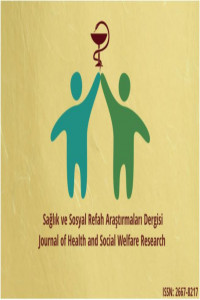JİNEKOLOJİ VE OBSTETRİDE HASTALARIN HEKİM CİNSİYETİ TERCİHLERİ VE ETKİLEYEN FAKTÖRLER
Jinekoloji, Obstetri, Cinsiyet, Hasta Tercihi.
PATIENTS PREFERENCES OF PHYSICIAN GENDER AND AFFECTING FACTORS IN GYNECOLOGY AND OBSTETRICS
Gynecology, Obstetrics, Gender, Patient Prefer.,
___
- Aksakal, O. Jinekolojik Muayenenin Psikososyal-Medikal Yönü. Türkiye Klinikleri Dergisi, 2001; 11(2),62-67.
- Altay, B., & Kefeli, B. Jinekolojik Muayeneye Gelen Kadınların Anksiyete Düzeyi ve Etkileyen Bazı Faktörler. Dokuz Eylül Üniversitesi Hemşirelik Yüksekokulu Elektronik Dergisi, 2012; 5 (4), 134-141. http://hdl.handle.net/20.500.12397/4623
- Amir H, Abokaf H, Levy YA, et al. Bedouin Women’s Gender Preferences When Choosing Obstetricians and Gynecologists. Journal of Immigrant and Minority Health. 2018;20:51-8. doi: 10.1007/s10903-016-0522-z
- Chandler PJ, Chandler C, Dabbs ML. Provider gender preference in obstetrics and gynecology: a military population. Mil Med 2000; 165: 938–940.
- Council on Garduate Medical Education. Fifth Report. Women and Medicine. U.S. Department of Healthand Human Services, Public health Services Resources and Services administration 1995.
- Deng, Z., Hong, Z., Zhang, W., Evans, R., & Chen, Y. The effect of online effort and reputation of physicians on patients’ choice: 3-Wave data analysis of China’s Good Doctor Website. Journal of medical Internet research, 2019;21(3),e10170. doi:10.2196/10170
- Feldman, P. Patients, Women Family Doctors, and Patient-Centred Care. Female Doctors in Canada: Experience and Culture, University of Toronto Press, London. 2019;271.
- Howell EA, Gardiner B, Concato J. Do women prefer female obstetricians? Obstet Gynecol 2002; 99: 1031–1035.
- Halim, N. A., Beaineh, P., Fenianos, M., Gebran, S., Msheik, A., Sharara, S., & Nabulsi, M. Preferences of Lebanese adults for the gender of their surgeons: a cross-sectional study. Eastern Mediterranean Health Journal, 2020;26(5),573-579. doi:10.26719/emhj.19.093
- Lambert, T. W., Smith, F., & Goldacre, M. J. Career choices for obstetrics and gynaecology: recent updates from 40 years of national surveys of UK medical graduates. JRSM open, 2019;10(10). doi: 10.1177/2054270419861611
- Marama T, Bayu H, Merga M, Buni W. Patient Satisfaction and Associated factors among client attmited to obstetrics and gynecology wards of Public hospitals and Mekelle Town, Ethiopia: An Instutiation-Based Cross Sectional Study.2018,1-9.doi: 10.1155/2018/2475059
- Mattar S., Nassar, A., Ghulmiyyah, L., Haddad, S., Tamim, H., & Hobeika, E. Factors that affect women’s choice of their obstetrician and gynecologist: a survey of Lebanese women. Clinical and Experimental Obstetrics & Gynecology,2019;46(3), 408-412. doi: 10.12891/ceog4648.2019
- Özbek, H. Pelvik Muayeneye Gelen Kadınların Yaşadıkları Anksiyete Düzeyine Demir ve Destekleyici Ebelik Yaklaşımının Etkisi. Cumhuriyet Üniversitesi Sağlık Bilimleri Enstitüsü. Yüksek lisans Tezi, 2006.
- Szymoniak, K., Cwiek, D., & Berezowska, E. Women's opinions regarding gynaecological examination in a hospital. Ginekol Pol, 2009;80(7), 498-502.
- Templeton, K., Bernstein, C. A., Sukhera, J., Nora, L. M., Newman, C., Burstin, H., ...& Busis, N. Gender-based differences in burnout: Issues faced by women physicians. NAM Perspectives, 2019;28,1-16. doi: 10.31478/201905a
- Turrentine, M., Ramirez, M., Stark, L., Snead, C., & Schulkin, J. (2019). Role of Physician Gender in the Modern Practice of Obstetrics and Gynecology: Do Obstetrician-Gynecologists Perceive Discrimination from their Sex?. Southern medical journal, 2019;112(11), 566-570. doi: 10.14423/smj.0000000000001034
- Wendt, E., Fridlund, B., & Lidell, E. Trust And Confirmation In A Gynecologıc Examınatıon Sıtuatıon: A Critical Incident Technique Analysis. Acta Obstetricia Gynecologica Scandinavica,2004; 83 (12), 1208–1215. doi: 10.1080/j.0001-6349.2004.00597.x
- Willis E, King D, Dwyer J, et al. Women and Gynaecological Cancer: Gender and the Doctor–Patient Relationship. Topoi. 2017;36:509-19. doi: 10.1007/s11245-015-9349-9
- Zuckerman M, Navizedeh N, Feldman J, et al. Determinants of women’s choice ofobstetrician/gynecologists. J Womens Health Gend Based Med 2002; 11: 175–180. doi: 10.1089/152460902753645317
- Yayın Aralığı: Yılda 2 Sayı
- Başlangıç: 2018
- Yayıncı: Haşim ÇAPAR
KLİNİK ARAŞTIRMALARDA KURUMSALLAŞMANIN ÖNEMİ
SAĞLIK SEKTÖRÜ ÇALIŞANLARININ İŞ TATMİNLERİNE YÖNELİK LİTERATÜR İNCELEMESİ
HEMŞİRELİK 2.0: TÜRKİYE’DE HEMŞİRELİK BAKIMI VE EĞİTİMİNDE PARADİGMA DEĞİŞİMİ ÖNERİSİ
Bircan KARA, Canberk AKDENİZ, İbrahim KAVASLAR
COVİD-19 PANDEMİ SÜRECİNİN TÜRKİYE EKONOMİSİNE ETKİLERİNİN AMPİRİK ANALİZİ
Ayşegül HAN, Ceren PEHLİVAN, Gökhan KONAT
SAĞLIK ÇALIŞANLARININ KORONAVİRÜS ANKSİYETE DÜZEYİNİN BELİRLENMESİ
Özlem GÜDÜK, Serkan ELARSLAN, Yaşar SERTBAŞ
KARS’TAN ERZURUM’A “TAŞIMALI SAĞLIK”: BİR ALAN ÇALIŞMASI
Ümit KOLYİĞİT, Deniz ÖZYAKIŞIR
İŞ SAĞLIĞI VE GÜVENLİĞİ AÇISINDAN ÖZEL POLİTİKA GEREKTİREN ÇALIŞANLARIN DEĞERLENDİRİLMESİ
JİNEKOLOJİ VE OBSTETRİDE HASTALARIN HEKİM CİNSİYETİ TERCİHLERİ VE ETKİLEYEN FAKTÖRLER
